Setting up an easy-to-use and fast home network is becoming simpler as new technology comes out. A 16-port Gigabit Ethernet switch streaming HD content, online gaming, or smart home device integration becomes a critical piece for wired connections across competing devices. Performance and budget features often contradict each other creating difficulty in finding the perfect switch. This essay seeks to help you achieve a balanced approach by explaining the most competing and critical parts of switches in the market.
What is a 16-port gigabit ethernet switch?
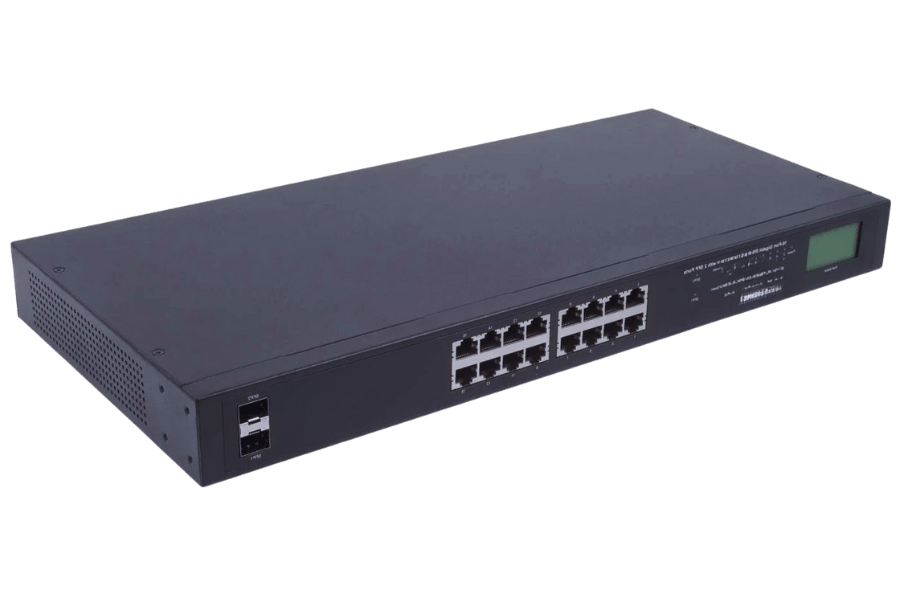
A 16-port Gigabit Ethernet switch is a network unit that enables the connection of multiple wired devices in a local network, including computers, gaming consoles, and smart TVs. It offers 16 Ethernet ports synchronous with a transfer rate of 1 Gbps which allows for faster and dependable communication between the devices. The switch functions as the main point of connection that helps to optimize data flow by controlling the data traffic and minimizing the overloaded data conditions. This makes it the perfect equipment for medium-sized residential networks or small offices.
Understanding gigabit speeds and its advantages
Gigabit speeds are defined as the movement of data across a network at a maximum of 1,000 megabits per second (Mbps), making the transfer of large files easier and the use of multifaceted applications much smoother. Some critical benefits that gigabit speeds add include lower streaming latency, no buffering for HD viewing, quicker file transfer rates, and better performance in multi-user simultaneous situations. Such advantages make gigabit speeds perfect for modern homes and businesses that depend on networks for entertainment, productivity, and seamless operational efficiency.
The role of a network switch in a home setup
A network switch is a device that improves the connectivity and overall function of a home network. As a central device of a network, a switch enables many devices within a Local Area Network (LAN) to communicate with each other and allows for the economical distribution of bandwidth. Most modern homes have smart TVs, gaming consoles, laptops, tablets, IoT devices, etc. All of these devices need high-speed and reliable connections.
With the modern gigabit Ethernet switches, data transfer rates have improved to an astonishing level: 1 Gbps per port. For regular home use, a 5-port or 8-port gigabit switch would suffice, as it allows for high throughput to all connected devices and prevents bottlenecking. Due to their plug-and-play nature and ability to configure themselves for multiple data streams at once, unmanaged switches are commonly used for homes.
Another perk of utilizing a network switch is traffic segmentation. Unlike a network hub which sends data to all devices, the switch sends data packets to the appropriate recipients, thus decreasing congestion on the network. Research has indicated that as much as a 40% increase within networks with dense devices can be achieved through more targeted approaches to data management.
Moreover, some high-end switches include support for technology features such as Quality of Service (QoS) prioritization which enables users to reserve bandwidth for particular applications such as video conferencing or gaming. This guarantees the functionality of smooth high-priority tasks even during heavy network usage. For those adding smart home gadgets, switches that feature Power over Ethernet (PoE) can simultaneously send power and data to compatible devices such as security cameras, making the installation less complicated and tidier.
Adding a network switch improves a home setup because of its scalability, making it easier to add more devices as needs grow. A reliable switch combined with gigabit internet speeds enhances the increased connectivity in a home, providing smooth access in today’s highly interconnected setting.
Comparing unmanaged vs. managed switches
While unmanaged and managed switches perform the same basic function, their differences become apparent based on the user’s needs and the functions required of the switch, particularly its control options, customization options, and features.
Unmanaged Switches
Automatic configuration and connection of devices to a network is a feature of gigabit unmanaged 16 port switches as well as other unmanaged devices, all of which are designed to be plug-and-play. Easy to use and inexpensive, these switches are ideal for small or home networks. Unlike managed switches, these devices perform only barebones tasks. For instance, they are capable of forwarding Ethernet frames, something an 8-port unmanaged switch does at an average cost of $20-50. Compared to managed switches, their simplicity translates into cost savings. Unfortunately, these unmanaged switches are unable to monitor network traffic or set QoS, meaning they are best suited to less complex networking scenarios.
Managed Switches
Managed switches provide greater control and customization of network traffic in addition to providing a higher level of oversight as compared to other switches. An administrator can control each port configuration, enable VLANs for traffic isolation, and even shape how each segment of traffic is passed using QoS, thereby configuring their systems. As a result, they tend to be more appropriate for enterprise, data centers, or any large-scale networks where security and performance represent greater challenges. Moreover, many managed switches now come equipped with various network monitoring tools tailored to assist in identifying issues along with their active resolution; for example, many managed switches today offer detailed analytics through SNMP (Simple Network Management Protocol). They are, however, considerably more expensive than other switches, starting at around $100 for lower-end models, and going into thousands of dollars for high-performance enterprise solutions.
Key Differences and Use Cases
| Feature | Unmanaged Switch | Managed Switch |
|---|---|---|
| Cost | Low ($20–$50 for basic models) | High ($100–$1,000+ depending on features) |
| Configuration | None required | Fully customizable |
| Traffic Management | Not supported | Supports QoS, VLANs, and traffic prioritization |
| Security Features | Basic (e.g., MAC address filtering) | Advanced (e.g., port security, ACLs) |
| Use Case | Home or small business networks | Enterprise, IT professionals, or complex setups often require a 16 port gigabit switch for enhanced performance. |
Ultimately, the choice between unmanaged and managed switches depends on your specific needs. For straightforward tasks like connecting a few devices in a home network, an unmanaged switch is sufficient, but a 16 port gigabit switch might be more future-proof. However, for large, dynamic networks requiring advanced control and scalability, a managed switch is the better option.
How to Choose the Right 16-port Gigabit Switch for Your Needs?
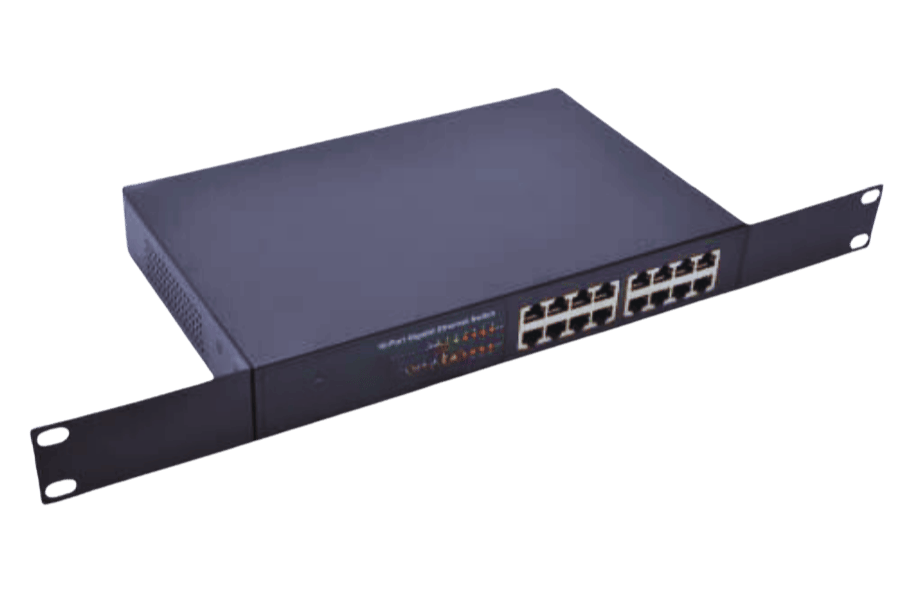
Assessing port requirements for your devices
Like any other upgrades to your network, you need to evaluate its current state and projections of future growth to plan its requirements. For small to mid-sized networks, a cost-effective option is the 16 Gigabit Ethernet port switch. Nevertheless, as with any switch, ensuring your device count is well within your total port availability is important. Assess your requirements by enumerating every device that will need network access, which usually include computers, servers, IP cameras, printers, and wireless access points. For instance, a small office with 14 desktop computers, 2 printers, and 2 access points totals 14 required ports. Still, planning on incorporating an additional 20 to 30% of devices or IoT implies additional access ports will need to be accounted for.
Think, as well, if any particular devices provided need the use of PoE, like IP cameras or VoIP. The power-over-ethernet function makes setup convenient and removes the hassle of having power supply units nearby as peripherals may be powered via Ethernet cables. Devices designed for neat installations can be powered through ports enabled for PoE. These factors assist in meeting immediate needs and accommodating room for additional power requirements so that devices on your switch can function effectively in various contexts. Therefore, for most use cases a standard 16-port PoE switch would be an ideal starting point.
Evaluating energy-efficient ethernet features
As EEE or IEEE 802.3az, Energy Efficient Ethernet is one of the standards set forth to tackle the power consumption issues within Ethernet devices during low data activity periods. This level of EEE utilizes network interfaces’ power management features that automatically shift to a low-power idle state when not full throttle is not required. This technology can cut power usage by 50% in certain situations which is why many organizations are looking for ways to enhance energy utilization in their networks.
A case in point is EEE’s implementation in an environment with a 16-port Gigabit switch. This saves a lot of operational energy costs because EEE enhances the energy-conserving capabilities of inactive ports to below the level needed to sustain network communications. Modern Ethernet switches that incorporate EEE functionality are capable of self-calibrating and modifying the power allocation in real-time based on the monitored data flow pattern which is very beneficial for networks with constantly changing bandwidth requirements. Other than that, they tend to embrace other energy-saving measures such as no fan designs or low power consuming parts, which results in a greater eco-friendly infrastructure.
As with any other sustainable IT approach, implementing EEE focuses on reducing energy consumption, because it greatly improves the operational expenditure, and the energy usage as well as the carbon footprint of a data center or a network operation. Ensuring EEE is implemented in a selected 16-port Gigabit switch could lead to greater uptime efficiency in the long run, as well as help to maintain green networking practices.
Factors to consider in a home network environment
In optimizing a home network, there are multiple interdependent factors that I consider. First, I examine the range of internet services supplied to the household, including streaming, gaming, video conferencing, etc., to see how best they can be accommodated. Following this, I consider the router’s location to ensure that the greatest amount of wireless internet coverage is available within the house and dead zones are kept to a minimum. Other than that, I look into the overall security of the network and set appropriate encryption levels as well as non-default usernames and passwords to prevent unauthorized users from accessing the network. Moreover, I take into account how easily the network can be altered in the future to accommodate new devices or smart appliances, ensuring these changes won’t require significant additional investments. Lastly, further, from other factors, I look into whether or not the devices used are EEE-enabled so that expenditure and environmental sustainability can be balanced easily.
What are the Key Features of a 16-port gigabit ethernet switch?
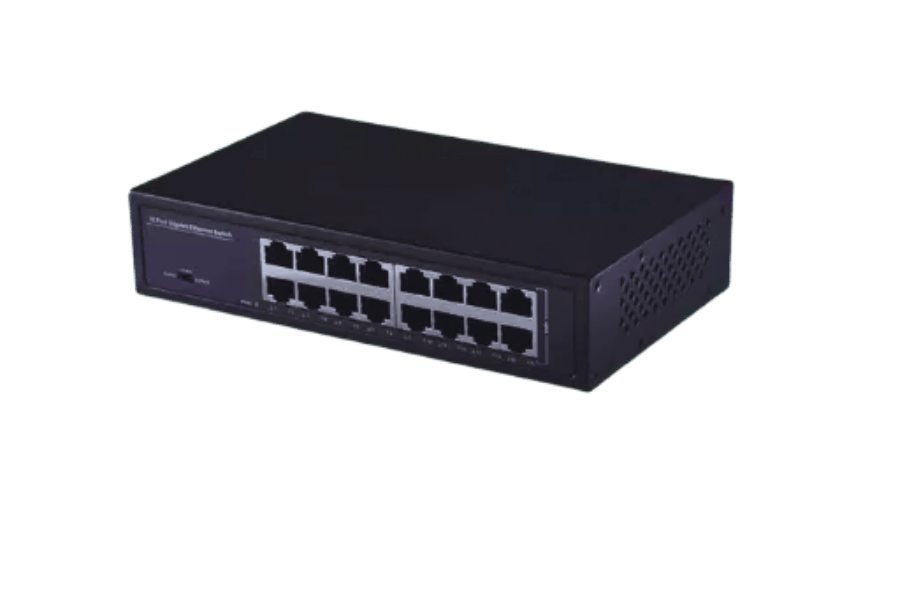
Importance of SFP ports for extended connectivity
SFP (Small Form-factor Pluggable) ports deeply impact 16-port gigabit ethernet switches because these ports are crucial in providing flexibility and enhanced connectivity options. These ports are very flexible for various network configurations since they can accept both fiber optic and copper cables through interchangeable modules.
Using fiber-optic SFP modules also increases the range of SFP ports to 80 kilometers, surpassing the standard ethernet cables support 100-meter limit. This makes SFP ports highly feasible for data centers and enterprise environments along with supporting large-scale networks since they require long-distance cabling.
Furthermore, these ports along using combinations of single-mode or multi-mode fibers help businesses to scale their networks. SFP+ modules and other businesses need help supporting 10 Gbps or more to effectively future-proof their infrastructure. For instance, SFP+ modules support 10 Gbps, and newer demand QSFP modules overcome higher expectations.
Lastly, SFP technology improves data accuracy over long distances due to fiber optic links being less affected by electromagnetic interference than copper cabling. This ensures optimal network performance in environments with considerable electronic or radio frequency disturbance.
The addition of SFP ports in switches allows companies to address contemporary network demands while preparing for future expansion, guaranteeing adaptability and strength within their networks.
Advantages of PoE in a 16-port POE setup
Reduced Simplification of Infrastructure
Power over Ethernet (PoE) technology combines both data and power in a single Ethernet cable. Signal and data transmission can now occur simultaneously, thus removing the need for additional power supply cables. The infrastructure necessary for powering devices is now simpler and more cost-effective.
Reduced Operational Expenses
A single 16-port PoE switch represents tremendous savings by integrating power delivery and data services into one device. For large-scale implementations, there are notable savings on electrical cabling and outlet installation as well.
Centralized Device Power Control
Maintenance and control of the devices connected to PoE switches is more efficient. They integrate central management which enhances monitoring and control of the devices as they can be remotely powered on and off.
Wider Scale Deployment
This configuration can accommodate multiple devices such as IP cameras, VoIP phones, and wireless access points. Thus, it can create tailored solutions for offices, industrial sites, and campuses.
Enhanced Power Performance
The 16-port PoE switch supports PoE Standards IEEE 802.3af and 802.3at, delivering up to 30W per port, and supporting high power devices. It is capable of advanced wireless access points or PTZ cameras.
Effective Use of Space
A 16-point PoE switch combines power delivery and network connectivity, thus cutting down the number of required devices which saves rack space and improves network organization.
Flexibility in Device Positioning
Because of the capability to power devices up to 100 meters away from the switch, PoE’s flexibility in device positioning becomes a great advantage, especially in cases where power outlets are difficult or impossible to install.
Improved Administration of the Network
Other than the basic capabilities of a 16-port PoE switch, many come with management capabilities that enable VLAN configuration, QoS settings, and performance monitoring. All of these, alongside what a 16 port gigabit switch offers, improve control over networked devices and overall efficiency.
Power Supply Redundancy
Supply redundancy can be achieved by linking PoE switches to Uninterruptible Power Supplies (UPS). This allows the devices to receive uninterrupted power during outages. It is extremely useful for sustaining the functionality of communication infrastructures or security systems.
Support for Growth Strategies
Installing a 16-port PoE switch enhances the possibilities for growth by easily integrating new devices, thus meeting the ever-increasing expectations and demands of the network. In addition, compliance with new standards of PoE ensures it will not quickly become obsolete.
This flexibility, affordability, and power make the modern networking environment a 16-port PoE configuration that provides streamlined power and connection management across diverse applications.
Exploring plug-and-play vs. configuration options
In the search for network solutions, the choice between plug-and-play technology and more intricately configured options can greatly influence the level of performance, scalability, and complexity of a setup.
Plug-and-Play Solutions
Passed Forward, Inc. has introduced unique solutions that are efficient and easy to implement. Unlike manual setup procedures, plug-and-play devices integrate themselves into a network automatically – all they require is power and a proper connection. Consequently, they are ideal for situations with pre-defined time limits and technical knowledge constraints. For example, a well-designed plug-and-play 16-port PoE switch can significantly cut business costs by enabling SMBs to manage installation expenses associated with IP cameras, VoIP phones, and wireless access point integration. Industry analysts have reported that installation of plug-and-play shift scheduling devices can expedite deployment timelines by up to thirty percent over systems that rely on extensive configuration.
Configurable Solutions
Configurable devices, on the other hand, offer greater control and customization options, making them appropriate for more advanced and fluid contexts. IT Administrators can adjust settings to accomplish defined goals related to performance, security, and traffic management by enabling VLANs, QoS (Quality of Service), and advanced monitoring features. For instance, in a corporate setting, configuring a PoE switch has the added benefit of letting administrators control bandwidth for business-critical applications, which consequently improves reliability. Although this method requires more technical knowledge and increased time for preliminary configuration, it provides greater adaptability and scalability with some reports noting up to 40% improved efficiencies in optimized network management.
Key Considerations
The decision between plug-and-play and configurable solutions is dictated by the specific organizational requirements of the network, as well as the level of expertise available. Plug-and-play works great for simple deployments that are time bound, while configurable plug-and-play systems perform better under demanding long term network conditions.
Comparing Popular Brands: Netgear vs. TP-Link
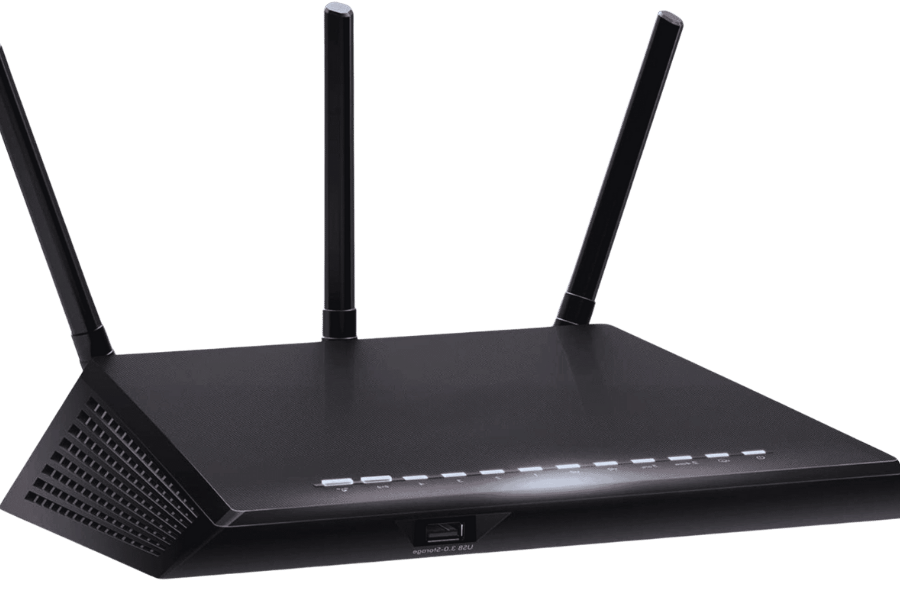
Review of Netgear 16-port gigabit ethernet switch
With reliable and efficient connectivity for small to medium-scale businesses, the Netgear 16-Port Gigabit Ethernet Switch is an outstanding performance device. It comes equipped with 16 auto-sensing gigabit ports, which deliver a capacity of 1 Gbps per port, therefore providing a total switching capacity of 32 Gbps for data transfer without pause.
Another feature of this high-performing switch is that it is custom-designed to save energy, thus complying with the IEEE 802.3az Energy Efficient Ethernet standards. Increased Ethernet traffic is not an issue, and less power is consumed when traffic is low. Moreover, the design is also fanless, making the device silent.
Rapid deployment is made possible as the plug-and-play feature requires no prior configuration. Lastly, Netgear comes with surge protection, enhancing the protection connected devices have against power fluctuations. Not only does this 16-port switch come with metal housing for Netgear durability, but the device is also rack-mountable.
The primary concern alongside bandwidth generated from video conferencing and file transfers, remains latency. This switch tackles high levels of bandwidth all while ensuring low latency. Not only does the device support IPv4 and IPv6, having modern network standards, but it also supports infrastructure enhancements in the future, showcasing profound adaptability.
All things considered, the Netgear 16-Port Gigabit Ethernet Switch remains an excellent option for those who need a simple, reliable, and easily extendable network system, as its comprehensive features and dependable operation aid in managing the network.
Features and benefits of TP-Link alternatives
Affordable Options
Often provide lower pricing TP-Link alternatives offer lower pricing while keeping important functions for small to mid-sized networks featured, making it a cost-effective selection for users looking to save.
Flexible Installation Arrangements
Many Other alternatives offer installation flexibility such as wall mountable and rack mounted catering to different workspaces and floor plans.
Consistent Performance
Minimally disrupting steady High bandwidth applications like streaming, file sharing, and online collaboration are supported by these alternatives which are designed to deliver stable connectivity.
Broad Compatibility
Integrated across devices With 16 port gigabit switches Broad Compatibility ensures integration across devices is seamless.
Commonly provided by alternatives support for existing networks and modern networks is guaranteed through IPv4 and IPv6 protocols.
Intergrated with user-friendly interfaces, provided by most options enabling intuitive management of devices, structured and setting processes network monitoring is accessible to users regardless of their technical skills, making efficient configuration possible.
By these specific characteristics focusing on these characteristics allows TP-Link alternatives to serve as practical and reliable diverse networking solutions.
Customer satisfaction and support comparison
When evaluating customer satisfaction and support, TP-Link’s competitors seem to prioritize user-friendly and prompt help for the customers. Most of the providers have active support systems like live chat, email, and telephonic assistance which aids in resolving most issues promptly. There are also several online self-help tools, such as FAQs, user manuals, and community forums, that enable customers to solve many routine issues on their own. Data from customer surveys suggests that companies with helpful customer service representatives and detailed guides tend to provide better satisfaction levels and are, therefore, a preferred choice for users who are looking for reliable support services.
Installation and Setup Guide for a 16-port gigabit ethernet unmanaged switch
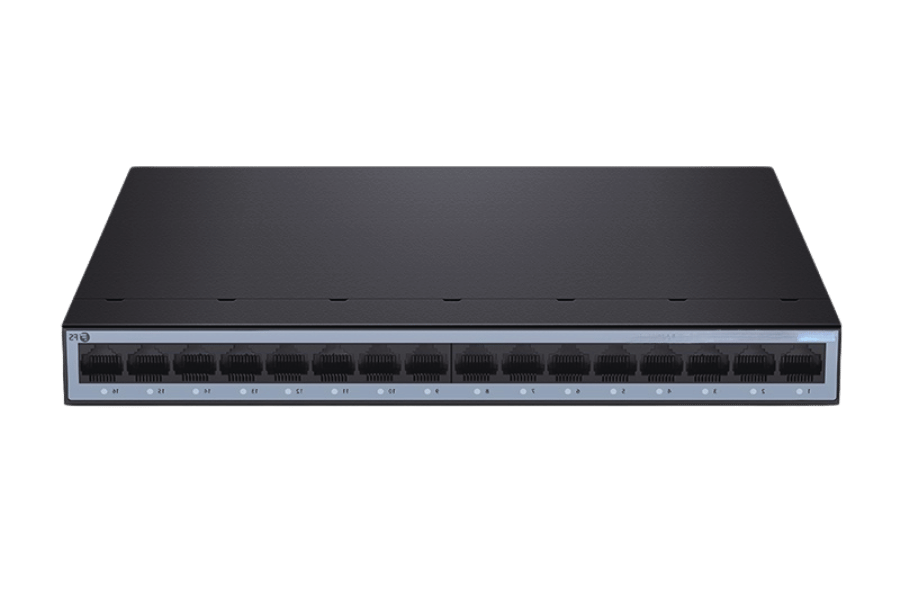
Step-by-step installation process
Unboxing the Switch
Take out of the 16-port unmanaged gigabit Ethernet switch untethered from its box, power adapter, and relevant documents as these need to be checked first.
Selecting The Location Of The Installation
Set the switch on a stable and flat surface or mount it on a rack if it is rack-mountable. Confirm that the placement allows for proper ventilation, devoid of direct heat, and in proximity to electricity and network devices.
Connecting Power
The power outlet needs to be plugged into the adapter of the switch so that the latter can be placed in the electrical socket. Upon doing so, the switch light indicator needs to be checked if it is functional.
Connecting to Network Devices
Computers or other networked devices need to be plugged into the switched ethernet ports using CAT5e or CAT6 Ethernet cables. It should be ensured that they are properly fastened in the above-mentioned ports.
Verifying LED Indicators
Switch port status must be checked and lights should be present at each used port for connection confirmation with the respective devices.
The switch now is ready for setup and does not require any configuration on behalf of unmanaged switches.
Connecting devices and optimizing network traffic
Correct device connections and strategized management of network services lead to efficient device intercommunication as well as performance improvements in network infrastructure efficiency. Following is a complete guide on how to achieve these results:
1. Use High-Quality Ethernet Cables
High-quality Ethernet cables offer better data transmission, which includes CAT6 and CAT6a. Other than supporting high speeds (10 Gbps for short distances depending on cable specifications), these cables limit interference such as crosstalk.
2. Use VLAN Grouping to Improve a Network’s Traffic
To reduce congestion or contain busy traffic for larger networks, VLANs can be used to group the endpoint devices. The VLAN configurations support hierarchical routing, enabling more vital segments of data enclosed within the sensitive area to operate freely without interference from the other segments for optional data.
3. Set up QoS
Most of the modern network switches support QoS (Quality of Service) functionality and protocols. Setting up QoS lets a network administrator prioritize signal and data traffic sent from or received by less active devices, including video conferencing units and VoIP instruments which are considered more active than downloading files.
4. Use Integration Monitoring Tools
The network monitoring tools that are SNMP compatible offer solutions for bandwidth use tracking. The access that they provide concerning high bandwidth utilizing devices or applications would allow changes to be made to aid distribution balance or even throttle excess usage.
5. Upgrade Switches for Additional Functionality
Having Layer 3 functionalities lets switches do inter-VLAN routing. These capabilities help remove several bottlenecks associated with having a single central router for intranet traffic.
6. Optimize Device Positioning
Connection to the switch at the ports and the relative placement of network devices improves load balancing which minimizes single-port overload. This helps reduce packet loss, provides optimal workload distribution across network devices, and improves overall switch performance.
7. Examine Network Traffic Analytics
Switch diagnostic utilities can be leveraged alongside external software. These aids facilitate learning and help to refine analytics for better future outcomes as well as prepare the network for scalable demands from changing organizational needs.
Implementing these strategies will enable more effective device interconnectivity and reduced resource latency while improving resource utility, thus enhancing overall network environment stability and reliability.
Common troubleshooting tips
Diagnose Connectivity Issues
First, verify that physical connections such as cables and plug-in points are secured and functioning correctly. Employ network cable testers to diagnose broken or faulty cables. Ensure that all devices are turned on and properly configured with the correct IP addresses, subnet masks, and device settings.
Check for Overloaded Switch Ports
Overutilization of ports results in relevant packet loss and becomes a source of latency. Solving this issue requires the use of switch monitoring tools to analyze traffic on ports. For ports identified as perpetually overutilized, shift traffic over or upgrade to higher switches to alleviate demand.
Update Firmware and Software
Incompatibilities or loopholes connected to obsolete switches firmware or device drivers. This can be prevented by having active checks on the manufacturer’s website, as well as verifying that all connected devices such as routers and endpoint machines have the most recent software versions installed.
Analyze Bandwidth Utilization
This problem arises from excessive use of bandwidth. Evaluation of active devices or applications that consume the most bandwidth may be conducted using internal monitoring functions of the switch or external analytic tools. Prioritize critical traffic such as enterprise applications or video teleconferencing with Quality of Service (QoS).
Minimize Conflict of IP Addresses
In a single ethernet network, if two or more devices try to use the same IP address, an IP address conflict occurs. Given this problem, devices in a network can be set to dynamically receive IP addresses through DHCP, or in the case of static assignments, unique IP addresses can be allocated to each device in the correct range. Conducting an IP conflict detection scan will make sure any present conflicts are dealt with promptly.
Look for Network Sniffing
Without proper management, network loops can be very destructive. If the switches do not incorporate STP, a loop can easily form. Turning STP on each switch or using managed switches will reduce broadcast storms and other looping problems.
Check Network for Latency Problems
Identify important delay regions for your network by using latency testing tools like packet pinging and tracerouting. Other than subpar network performance, there can be serious physical link issues, excessive device load, or malfunctioning routers causing the routing protocol to employ nonoptimal pathways. To solve the problem, check the devices’ positions and configurations.
Ethical Hacking of Security Measures
Invasion of a network enables unauthorized users to access private information which can cause an unusual decline in the performance of the system. To prevent this kind of attack, ensure that MAC address filtering, 802.1X authentication, and VLAN network segmentation are turned on. Actively track access logs to watch for signs of abnormal behavior.
Modify the VLAN setup for optimal traffic flow as usage grows in a network with a 16-port gigabit switch.
If VLANs are not configured properly, they can create connectivity issues or block traffic too aggressively. Check all VLAN configurations for correct tagging and trunking between devices. Apply VLAN monitoring techniques to verify that traffic is appropriately segmented at the interfaces within the network.
VLANs must be set up in a way that allows for their effortless expansion vertically and horizontally.
If performance issues continue to improve, look into whether the existing infrastructure could be a limitation. Strategically plan by adding more powerful switches, extra access points, or incorporating cloud services to relieve on-premise load. Such a strategy ensures that increased network usage does not lead to excessive troubleshooting needs, especially in systems that rely on or incorporate a gigabit ethernet 16 port switch.
Following advanced problem-solving strategies improves network administrators’ capability to isolate and solve problems, optimizing overall network performance.
Frequently Asked Questions (FAQs)
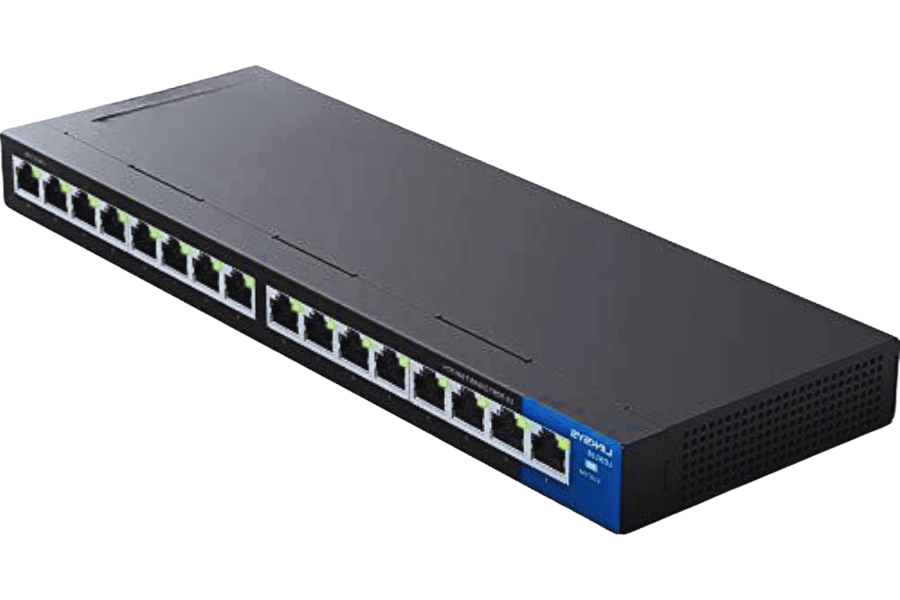
Q: What are the most important characteristics of a 16-port gigabit Ethernet switch for home use?
A: For home use, attributes like unmanaged operation for simple setup, gigabit speeds on all ports, energy-efficient Ethernet, VLANs, and potentially PoE support should be considered when selecting a 16-port gigabit Ethernet switch. Some models even include 2 SFP ports for future fiber optic connections, which can help in 16-port gigabit configurations.
Q: What is the distinction between managed and unmanaged 16-port gigabit Ethernet switches?
A: A plug-and-play, unmanaged 16-port gigabit Ethernet switch requires no configuration and is most suited for home networks. A managed switch provides additional features like more control over traffic, VLANs, and network security, requiring technical knowledge for setup, maintenance, and ongoing management. Most home users will prefer the simplicity offered by an unmanaged Ethernet switch rather than a complex 16-port gigabit switch.
Q: Do I need a PoE switch for my home network?
A: Yes, a PoE switch would be useful in a home network setup if one has devices such as IP cameras, VoIP phones, or wireless access points that serve to uplink with Ethernet cables. PoE permits the powering of these devices through the Ethernet cable, eliminating the necessity for independent power sources. Conversely, if there are no relevant devices, a standard 16-port gigabit switch will do the job without any PoE functionality.
Q: How does a 16-port gigabit Ethernet switch improve my home network?
A: PoE-compatible devices can enhance a home network by integrating more Ethernet-connected peripherals. A 16-port gigabit Ethernet switch will dramatically boost the performance parameters of a home network. They provide an ample amount of Ethernet ports, guarantee that every device linked to the network receives gigabit speeds (exceeding 1,000 Mbps), and, in turn, mitigate the bottleneck effect in the network. All of which enables enhanced performance in file transfers, streaming, and overall improvement in network speed across various devices connected to the network.
Q: Explain the significance of having 2 SFP ports on a 16-port gigabit Ethernet switch.
A: The usage of SFP (Small Form-factor Pluggable) ports permits the employment of fiber optic connections which offer greater bandwidth and longer cable runs than Ethernet cabling. Accessing 2 SFP ports on a 16-port gigabit Ethernet switch enables the user to link to fiber networks or high-speed uplink switches and network devices later on.
Q: What do you consider while looking for a brand that sells 16-port gigabit Ethernet switches?
A: While switching to another brand, check if they offer services like reliability, warranty, additional features, and customer support. Their Netgear, TP-Link, and D-Link brands are popular and sell quality 16-port gigabit switches. Make sure that the switch complies with IEEE standards, supports Energy Efficient Ethernet, and provides proper thermal management. Based on user reviews and specifications, assess them to make a choice that best suits your financial resources and needs.
Q: Can I replace my router with a 16-port gigabit Ethernet switch?
A: A 16-port gigabit Ethernet switch cannot replace your router. A switch does not route traffic between sub-networks. It expands Ethernet ports and organizes your local area network. A router, on the other hand, connects your local area network to the internet. They also provide network services like DHCP, NAT, and firewall bounds. You will still need a router with your switch for a complete home network setup.
Q: How do I set up a 16-port gigabit Ethernet switch in my home network?
A: Setting up an unmanaged 16-port gigabit Ethernet switch is quite simple. Just plug the switch into your router via an Ethernet cable and plug your devices into the switch’s ports. Make sure you are using Cat5e or Cat6 Ethernet cables to achieve gigabit speeds. The switch will automatically detect any devices plugged into it and will enable them to communicate on the network at gigabit speeds.
Reference Sources
1. Title: 8×16 Wavelength Selective Switch With Full Contentionless Switching
- Authors: Zhilin Yuan et al
- Publication Date: April 1, 2019
Summary:
- In this work, the authors discuss the 8×16 Wavelength Selective Switch (WSS) which performs full contentionless switching. The switch contains two chips of liquid crystal on silicon (LCOS) and uses a dual LCOS architecture which enables the switching, attenuation, or blocking of optical wavelengths among 8 input ports and 16 output ports. The insertion loss is reported to be less than 14 dB and the device has a bandwidth tuning range of 50 to 5000 GHz. The device demonstrates significant performance improvements over previous designs, achieving high optical switching versatility and efficiency.
Methodology:
- The authors used liquid crystal devices to design and fabricate the WSS. Their goal was to optimize the switching performance, hyper the efficiency of WSS-attached devices, and minimize insertion loss. The proposed architecture was validated based on a set of experimental results that were claimed to be effective.
2. Title: Development of power over ethernet switchboard with a Gigabit network interface
- Authors: Liming Wang et al.
- Publication Date: October 1, 2017
Summary:
This work analyzes the construction of a military-grade switchboard with throughput capabilities of Power over Ethernet (PoE) through 5 ports switches and Gigabit. The described switchboard is capable of automatically allocating the needed IP addresses, building step-by-step, high-speed local area networks, as well as detecting power demand. The design is sought to assist in the control of connecting nodes in extremely difficult environmental conditions.
Methodology:
Military application usually requires very specific configurations and associated interfaces. Therefore, the authors have built all-inclusive comprehensive design which includes circuit design, individual switchboard testing. The control of the switchboard functionality was performed by various exercises to confirm guarantees.
3. Gigabyte Ethernet Controller With Fault Tolerance Prevention Features
- By: Longfei Li with others
- On: July 1, 2017
Abstract:
- In this paper, the author describes the design and implementation of LCE5718, an Advanced Gigabit Ethernet Controller that offers fault-tolerant transmission and prevention mechanisms based on link aggregation of IEEE 802.3ad. The controller was designed in such a way that it maintains connection so long as one of the channels does not fail, thereby ensuring the reliable performance of the network.
Methodology:
- The authors reported controlling the device in field programmable gate arrays and conducting many experiments to test its performance. The design is reported to accomplish link aggregation through a dual-port model. They also included a fault prevention mechanism that issues device status reports to supervisors for immediate action.
Related Products:
-
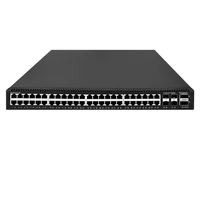 S3100-48T2Q4X, 48-Port Ethernet Switch, 48x 10/100/1000/2500/10G BASE-T RJ45, with 2x 40G SFP+ and 4x 1G/10G SFP+ Uplinks
$1095.00
S3100-48T2Q4X, 48-Port Ethernet Switch, 48x 10/100/1000/2500/10G BASE-T RJ45, with 2x 40G SFP+ and 4x 1G/10G SFP+ Uplinks
$1095.00
-
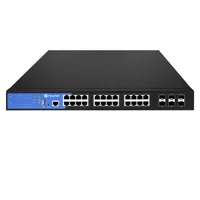 S3100-24T6X-P, 24-Port Ethernet Switch L3, PoE+ Switch, 24x 10/100/1000/2500 BASE-T RJ45, with 6x 1G/10G SFP+ Uplinks
$746.00
S3100-24T6X-P, 24-Port Ethernet Switch L3, PoE+ Switch, 24x 10/100/1000/2500 BASE-T RJ45, with 6x 1G/10G SFP+ Uplinks
$746.00
-
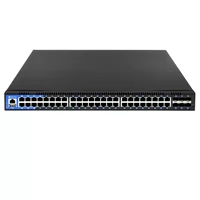 S3100-48T6X-P, 48-Port Ethernet Switch L3, PoE+ Switch, 48x 10/100/1000BASE-T RJ45, with 6x 1G/10G SFP+ Uplinks
$734.00
S3100-48T6X-P, 48-Port Ethernet Switch L3, PoE+ Switch, 48x 10/100/1000BASE-T RJ45, with 6x 1G/10G SFP+ Uplinks
$734.00
-
 S3100-8T4X, 8-Port Ethernet Switch L3, 8x 10/100/1000/2500/10G BASE-T RJ45 Ports, with 4x 1G/10G SFP+ Uplinks
$398.00
S3100-8T4X, 8-Port Ethernet Switch L3, 8x 10/100/1000/2500/10G BASE-T RJ45 Ports, with 4x 1G/10G SFP+ Uplinks
$398.00
-
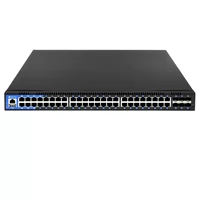 S3100-48T6X, 48-Port Ethernet Switch L3, 48x 10/100/1000BASE-T RJ45, with 6x 1G/10G SFP+ Uplinks
$365.00
S3100-48T6X, 48-Port Ethernet Switch L3, 48x 10/100/1000BASE-T RJ45, with 6x 1G/10G SFP+ Uplinks
$365.00
-
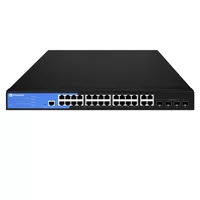 S2100-24T4TS-P, 24-Port Ethernet Switch L2+, PoE+ Switch, 24x 10/100/1000BASE-T RJ45, with 4x 1G RJ45/SFP Combo Uplinks
$360.00
S2100-24T4TS-P, 24-Port Ethernet Switch L2+, PoE+ Switch, 24x 10/100/1000BASE-T RJ45, with 4x 1G RJ45/SFP Combo Uplinks
$360.00
-
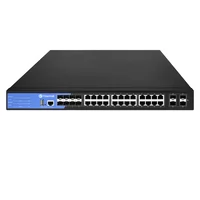 S3100-16T8TS4X, 16-Port Ethernet Switch L3, 16x 10/100/1000BASE-T RJ45, with 8 x 1Gb RJ45/SFP Combo and 4 x 1Gb SFP Uplinks
$340.00
S3100-16T8TS4X, 16-Port Ethernet Switch L3, 16x 10/100/1000BASE-T RJ45, with 8 x 1Gb RJ45/SFP Combo and 4 x 1Gb SFP Uplinks
$340.00
-
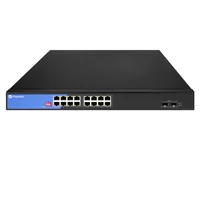 S2100-16T2S-P, 16-Port Ethernet Switch L2+, PoE+ Switch, 16x 10/100/1000BASE-T RJ45, with 2x 1G SFP Uplinks
$230.00
S2100-16T2S-P, 16-Port Ethernet Switch L2+, PoE+ Switch, 16x 10/100/1000BASE-T RJ45, with 2x 1G SFP Uplinks
$230.00
-
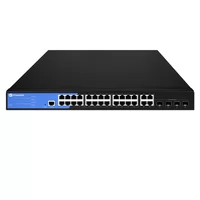 S2100-24T4TS, 24-Port Ethernet Switch L2+, 24x 10/100/1000BASE-T RJ45, with 4x 1G RJ45/SFP Combo Uplinks
$148.00
S2100-24T4TS, 24-Port Ethernet Switch L2+, 24x 10/100/1000BASE-T RJ45, with 4x 1G RJ45/SFP Combo Uplinks
$148.00
-
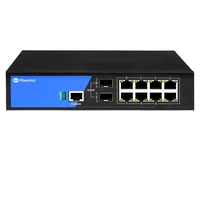 S2100-8T2S-P, 8-Port Ethernet Switch L2+, PoE+ Switch, 8x 10/100/1000BASE-T RJ45, with 2x 1G SFP Uplinks
$139.00
S2100-8T2S-P, 8-Port Ethernet Switch L2+, PoE+ Switch, 8x 10/100/1000BASE-T RJ45, with 2x 1G SFP Uplinks
$139.00
-
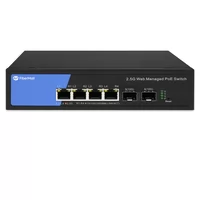 S3100-4T2X-P, 4-Port Gigabit Ethernet Managed Switch, PoE+ Switch, 4x 10/100/1000/2500 BASE-T RJ45, with 2x 1G/10G SFP+ Uplinks
$90.00
S3100-4T2X-P, 4-Port Gigabit Ethernet Managed Switch, PoE+ Switch, 4x 10/100/1000/2500 BASE-T RJ45, with 2x 1G/10G SFP+ Uplinks
$90.00
-
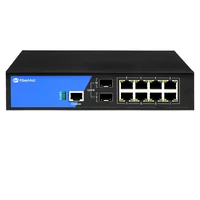 S2100-8T2S, 8-Port Ethernet Switch L2+, 8x 10/100/1000BASE-T RJ45, with 2x 1G SFP Uplinks
$71.00
S2100-8T2S, 8-Port Ethernet Switch L2+, 8x 10/100/1000BASE-T RJ45, with 2x 1G SFP Uplinks
$71.00
